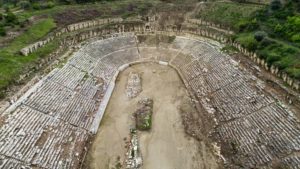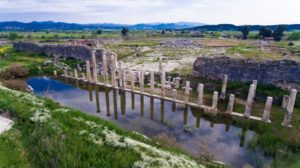The goddess of the night, the hometown of silver-browed Artemis, Magnesia
The Goddess of the Night, Magnesia, the hometown of Artemis, the Silver Brow, has one of the most aesthetic and extraordinary temples built in honor of the goddess. The temple of Artemis where today’s researchers have written hundreds of articles and published volumes of books was built by Hermogenes who was the greatest architect of ancient times. The new techniques and aesthetic values used in this temple have continued its influence for thousands of years. Traces of innovations affecting many trends, from Renaissance to modern architecture, are still visible in Magnesia. The ruins of the city, where mathematics, geometry, physics and stone processing techniques, architecture and human skills are at their peak, tell their visitors what people can do 2,200 years ago.
Magnesia is an ancient city surrounded by city walls with a diameter of about 1,5 km. Magnesia is located at Germencik district of Aydin on the Ortaklar-Soke highway within the borders of the Tekin District, at the foot of Gumusdag (Thorax), on the edge of Gumuscay (Lethaios), the tributary of the Menderes River.
History of the City
Magnesia is a city with significant commercial and strategic potential in Ionia, at the intersection of Ephesos, Priene and Tralleis Ancient Cities. He was famous for grain production and figs (as it is today). The city remained under the Persian rule until Alexander the Great, King of Macedonia (336-323 BC). The first years of Seleucus and later the Kingdom of Pergamon were considered as the most magnificent period of the city. During the Byzantine Empire, it was known to be the episcopal center until the 12th century.
Research History
The first excavation in Magnesia was carried out by the French Government in 1842-43; Some of the friezes of the Temple of Artemis were taken to the Louvre Museum in Paris. The actual information about the city is based on 21 years of excavations by Germany. Theater, artemision, agora, Temple of Zeus and prytaneion were carried out and the architectural elements and sculptures were sent to Istanbul Archeology Museums and Berlin Pergamon Museum. Recent excavations are being carried out on behalf of Karabük University.
Theater
Theatron is a structure that differs from other theaters known because of the entrance in the middle of the podium and the proedrie on the sides. Because of this feature, “theatron” is defined as (audience place). It is assumed that it remains unfinished due to landslides. Being unfinished is the most important feature. The theater informs us about how the plans are built. The workmanship of the foundations (in the back, right to left) and marble blocks proves to be unfinished. If it was finished, it would be a concert structure in which Magnesia Olympic Games named Leukophryena and music contests would be held and the unfinished blocks on the podium would be embossed like the stadium. Had it been finished, it would have had a structure of seven kerkis (sliced), double diazoma (intermediate way) and about 4,700 people. Excavations started in 1984 continued at intervals and were completed in 2003. In 2004, the landscaping was completed and the works were completed.
Temple of Artemis Leukophryene
The ruins of the Temple of Artemis are just west of the highway. It is the fourth largest temple of the Hellenistic period in Anatolia. It is the work of the architect Hermogenes. It was the first time in the temple that he invented a plan, which he described as se pseudodipteros ”(dipteros). The stylobate measures 41 x 67.5 m. This west-facing temple is Ionian in shape and has 8×15 columns. Attic type column bases and frieze with figures on the top of the columns are the first examples in Anatolia. Describes the battle of the Amazons, 175 m. the frieze and the building elements of the temple are exhibited in the museums of Istanbul, Paris and Berlin. It was excavated between 1891-93. As a result of the restoration works following the excavations on the western façade of the temple, the pediment of the western facade of the temple was rebuilt in the south of the temple, taking into account the original places of the fragments (anastylosis). The 28 column capitals of the temple are exhibited in the ruins.
Agora
From Artemision to the agora, it is entered through the propylon. It was excavated in sections between 1891-1893. And in time it was again under the 3 m high shaft layer. Excavations started in the agora in 2000 cannot be completed due to this high filling. The stoa surround the agora covering an area of 26 thousand square meters. The square covered with blocks was mainly for religious ceremonies. To the south of the square there was the Temple of Zeus, which has been buried today. The existence of a hitherto unknown cryptoporticus beneath the eastern stoa was partially revealed in 2002.
Stadion
It is located between the two hills extending in the north-south direction to the southwest of the city. The first studies were started in 2008. The stadium has a runway length of 189 m and has a capacity of approximately 30 thousand people. so that Turkey is also one of the world’s best preserved Stadions. It has very different features. Arena podium is very different from other stadiums due to the use of reliefs.
Magnesia Gymnasiums
Stadion Gymnasium
It is the highest remains that can be seen in Magnesia. There are three main sections, the bath, apodyterion and palaestr. Under the bath section, there are two long vaulted galleries, which are defined as under ground roads, going to Ephesus with a wrong interpretation and the places that connect them. A staircase can only be reached up to the third floor of the building. Apodyterion has two floors. There is a monumental entrance with stairs leading to the main street in the southwest corner. The Musalar Hall to the south was partially uncovered.
Lethaios Gymnasium
It is the second gymnasium of the city. It is at Ortaklar – Soke highway and east of railway. It is one of the few buildings on the edge of Lethaios (silver moon), deviating from the north-south direction. This must have been due to the necessity to conform to the position of the lethai. It is understood from the remains that the building, which was defined as “barracks tarafından by archaeologists, is a bath – gymnasion complex.
Transportation
Transportation to Magnesia is provided by private vehicles or buses via Izmir – Aydin highway, Selcuk, Aydin, Germencik or Soke. It is 100 km away from Izmir, 4 km from Ortaklar and 16 km from Soke. Those who prefer the highway, before the exit of Soke – Bodrum, 1,5 km when they turn to Ortaklar direction. Then they reach the service unit at the entrance of the ancient city.
Entrance
Visiting hours are 08.30-17.00 in winter and 09.00-19.00 in summer. It is open to visitors every day of the week. Access to Magnesia Ruins is free of charge.



